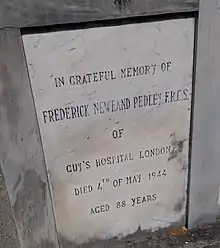Frederick Newland-Pedley (1855 – 1944) was a British physician and dentist known for his contribution to the fields of military dentistry and dental education.
Early life
Newland-Pedley was born in 1855.[1] He studied at Dulwich College and Guy's Hospital, becoming first a physician, a member of the Royal College of Surgeons of England in 1881 and a fellow of the same in 1885. In 1880 he received his L.D.S degree from the Royal Dental Hospital in Leicester Square.[1]
Career
At Guy's hospital he was appointed as a dental surgeon in 1887.[1][2] When the dentist he had been assisting became seriously ill, Newland-Pedley took up his responsibilities and also began the hospital's first dental department at his own expense.[1][2] In 1888 he proposed the idea of a dental school to the hospital's board; the school opened with twelve chairs the next year in 1889.[1][3][4]
From February to June 1900, Newland-Pedley volunteered in the British Army during the Boer War, becoming the army's first appointed field dentist.[5][6][7] He brought his own supplies and equipment, setting up in a tent to treat soldier's dental problems.[8][9] Returning from the war, he proposed to the British Army that a more permanent dental service be instituted.[10][11][12] This resulted in four dentists being sent on contract to the Boer war.[6][13]
During World War I, Newland-Pedley again served as a volunteer dental surgeon, this time at Rouen.[1]
Following the war, he practiced in London as a dentist, ultimately retiring to Italy.
He died at Lake Como, Italy, on 4 May 1944.[1] His headstone can be found along the northern wall of the Santa Maria Assunta church graveyard, located in Santa Maria Rezzonico, on the north west shore of Lake Como, Italy.

References
- 1 2 3 4 5 6 7 "Newland-Pedley, Frederick (1855 - 1944)". livesonline.rcseng.ac.uk.
- 1 2 Cartwright, F F (17 December 1966). "The Relationship of Medicine and Dentistry in the Nineteenth Century: Dental and Medical Education in the Nineteenth Century". Proceedings of the Royal Society of Medicine. 59 (12): 1237–1240. doi:10.1177/003591576605901204.
- ↑ "History | Faculty of Dentistry, Oral & Craniofacial Sciences | King's College London". www.kcl.ac.uk.
- ↑ "King's Collections : Archive Catalogues : GUY'S HOSPITAL MEDICAL SCHOOL: Records". kingscollections.org.
- ↑ "Adler Museum Bulletin". 1991.
- 1 2 Kochhar, P. C. (2000). History of the Army Dental Corps and Military Dentistry. Lancer Publishers. ISBN 9788170622857.
- ↑ Clarke, Nic (October 2015). Unwanted Warriors: Rejected Volunteers of the Canadian Expeditionary Force. UBC Press. ISBN 9780774828918.
- ↑ Hussey, K. D. (2014). "British dental surgery and the First World War: the treatment of facial and jaw injuries from the battlefield to the home front". BDJ. 217 (10): 597–600. doi:10.1038/sj.bdj.2014.1001. PMID 25415020. S2CID 21448749 – via www.academia.edu.
- ↑ https://bda.org/museum/Documents/What-the-Lindsay-Society-Does/For-web-Dental%20Historian%2062%20%282%29%20July%2017.pdf
- ↑ "New Zealand Dental Journal". 1938.
- ↑ Manson, Julius David (2003). Wilfred Fish and a Profession in the Making. Esmeralda Press. ISBN 9780953610211.
- ↑ "British Journal of Dental Science and Prosthetics". J. P. Segg & Company. 17 June 1915 – via Google Books.
- ↑ Alderson, G. L. D. (1 January 2014). Cap-badges of the British Army. The History Press. ISBN 9780752490069 – via Google Books.